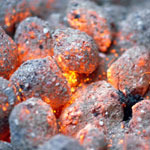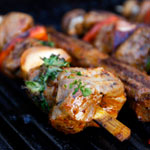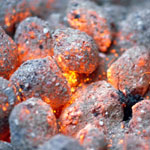How Safe Is Your Barbecue? 4 Deadly Food Safety Sins
What is it about warm weather that makes us want to turn up the heat by firing up the grill? Luckily, it's easy for summer lovers to satiate our barbecue cravings with char-grilled fare that's guilt-free. But is it safe?
With the heat of barbecue season comes the heightened risk of contracting a foodborne illness and ingesting dangerous chemicals — particularly whenever meat is on the menu. This summer, stay out of harm's way by sidestepping these serious food safety sins:
Foodborne Illnesses and How to Avoid Them
Food Safety Sin Number 1: Cross-Contamination
The transfer of bacteria from one place (typically meat) to another (such as hands or eating utensils) is a common culprit of foodborne illness, but these simple precautions will help you minimize your risk:
- Stay clean. Your mother probably said it a hundred times, but you should always wash your hands with antibacterial soap before you put a finger on your food.
- Scour all cooking surfaces such as the counter and cutting boards, plus utensils, and produce before whipping up any culinary masterpiece. If you're packing a picnic, make it a habit to clean out your cooler each and every time.
- Segregate your food groups. Raw meat should never be placed on the same prep area as raw vegetables. Stay safe by assembling salads and any other raw dishes only after the meat is on the grill, and then stick with separate utensils and dishware than those used for prepping raw meat.
- Pack smart. If you're taking your barbecue on the road, package foods in waterproof zip-top plastic bags; other packaging could get soggy and run the risk of contaminating or getting contaminated by other foods en route.
Food Safety Sin Number 2: Eating Undercooked Meat
Can't wait to eat that juicy burger just as soon as it turns brown? You'd better slow down! You can't always rely on the color that you see to assess safety. To be absolutely sure that your meat is completely cooked inside and out, stick a thermometer into the thickest part of the meat and familiarize yourself with the USDA's standard cooking temperatures:
- Whole and ground poultry should be cooked to 165 degrees Fahrenheit.
- Ground meats (such as burgers) should be cooked to 160 degrees Fahrenheit.
- Beef steaks and chops should be at least 145 degrees Fahrenheit.
- Fish will become flaky when cooked throughout, but make sure the temperature reaches 145 degrees Fahrenheit.
Once the temperature is right, it's safe to pile on the veggies; you should never stack vegetables top of meat before it's thoroughly cooked.(Photo courtesy of Thinkstock/Hemera).
Girl's Guide to Grilling Anything
Food Safety Sin Number 3: Leaving Leftovers Out
Always remember this cardinal rule: Keep hot foods hot and cold foods cold. To do so, keep cooked food on the grill until it's ready to be served, and keep cold foods on ice until they're ready to be eaten. Cold foods should be kept at or below 40 degrees Fahrenheit by using a block of ice, which stays cold longer than ice cubes. And since cold air travels downward, remember to put ice above — not just below — your foods and beverages.
Temperatures between 40 and 140 degrees Fahrenheit are called the "temperature danger-zone" where bacteria can grow faster than you can blink an eye. The temperature of your food should never fall between these two numbers for more than two hours (or one hour if the air temperature is warmer than 90 degrees Fahrenheit). Refrigerate any leftovers promptly and in shallow containers, which expedites rapid, even cooling. If you are ever in doubt, throw it out!
That smoky, borderline-burnt flavor is what keeps our grills hot all summer long, but it is also what makes grilling unhealthy. On the spectrum of food safety, charred food sits opposite undercooked food but is just as scary when consumed: Burnt food can expose your body to chemicals and potential carcinogens thanks to two chemicals coming out of your grill and transferred into your food: polycyclic aromatic hydrocarbons, or PAHs, are chemicals deposited onto food via the smoke that forms when meat fat drips onto hot coals; heterocyclic amines, or HCAs, are the chemicals created when the molecular components of meat react with each other due to prolonged exposure to high temperatures on a gas or charcoal grill. This may sound scary, but there are a few tricks to keep these chemicals out of your mouth while keeping the grilled food in it:
- Avoid burn marks. Eat your beef medium-well to avoid potentially dangerous chemicals in the charred proteins. If you do get some charred marks (on meat or veggies), just scrape or chop them off.
- Use lean meat. Forgoing fatty meats for leaner cuts will do wonders for heart health, and it also reduces the development of PAHs.
- Cut before you cook. Smaller pieces of meat will cook more quickly, thereby requiring less exposure to both heat and potentially dangerous smoke.
- Marinate your meat. Meat marinated with acids (think lemon juice or vinegar) can lessen the formation of HCAs.
- Fill your grill with produce. The buildup of HCAs is associated with grilling protein-rich foods such as chicken and steak, but vegetables don't create these particular carcinogens. Try grilling corn, asparagus, or carrots.(Photo courtesy of Thinkstock/Goodshot).
More from Women's Health:
How to Grill: Bobby Flay's Grilling Tips
- Keri Glassman, Women's Health
This post was originally published on July 23, 2012


